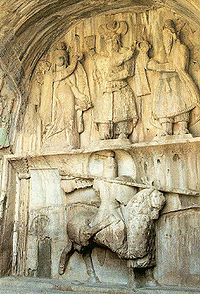- Clibanarii
-
The oldest known relief of a heavily armoured cavalryman, from the Sassanid empire, at Taq-i Bostan, near Kermanshah, Iran (4th century).


This article is part of the series on:
Military of ancient Rome (portal)
753 BC – AD 476Structural history Roman army (unit types and ranks, legions, auxiliaries, generals) Roman navy (fleets, admirals) Campaign history Lists of wars and battles Decorations and punishments Technological history Military engineering (castra, siege engines, arches, roads) Political history Strategy and tactics Infantry tactics Frontiers and fortifications (limes, Hadrian's Wall) The Clibanarii or Klibanophoroi (Greek: κλιβανοφόροι, meaning “camp oven-bearers” from the Greek word κλίβανος meaning "camp oven" or "metallic furnace") were a Sassanid Persian, late Roman and Byzantine military unit of heavy armored horsemen. Similar to the cataphracti, the horsemen themselves and their horses were fully armoured. There are several theories to the origins of this name, one being that the men were literally nicknamed “camp oven bearers” (due to the amount of armour they wore that the troops heat up very quickly in the heat of battle) or that the name is derived from Persian word griwbanwar or griva-pana-bara meaning "neck-guard wearer"
The Clibanarii were used mostly by Eastern armies; for example, they were used by the Palmyrene Empire, and fought against the Roman cavalry at Immae and Emesa. Sassanids employed Clibanarii in their western armies, mainly against the Eastern Roman empire. They were more heavily armoured than their Byzantine counterparts. The Clibinarii cavalry of Shapur II is described by Greek historian Ammianus Marcellinus, a Roman staff officer who served in the army of Constantius II in Gaul and Persia, fought against the Persians under Julian the Apostate, and took part in the retreat of his successor Jovian, as:
"All the companies were clad in iron, and all parts of their bodies were covered with thick plates, so fitted that the stiff-joints conformed with those of their limbs; and the forms of human faces were so skilfully fitted to their heads, that since their entire body was covered with metal, arrows that fell upon them could lodge only where they could see a little through tiny openings opposite the pupil of the eye, or where through the tip of their nose they were able to get a little breath. Of these some who were armed with pikes, stood so motionless that you would have thought them held fast by clamps of bronze.
"The Persians opposed us serried bands of mail-clad horsemen in such close order that the gleam of moving bodies covered with closely fitting plates of iron dazzled the eyes of those who looked upon them, while the whole throng of horses was protected by coverings of leather."Contents
See also
References
Primary sources
Secondary sources
- Hugh Elton, Warfare in Roman Europe
Categories:- Cavalry
- Warfare of the Middle Ages
- Types of cavalry unit in the army of ancient Rome
- Military units and formations of the Sassanid Empire
- Military units and formations of the Byzantine Empire
- Late Roman military units
Wikimedia Foundation. 2010.

